The Tumour Ablation Devices Market is estimated to be valued at USD 2.2 billion in 2025 and is projected to reach USD 7.8 billion by 2035, registering a compound annual growth rate (CAGR) of 13.8% over the forecast period.
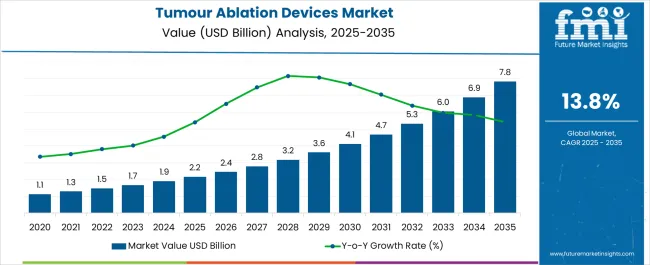
| Metric | Value |
|---|---|
| Tumour Ablation Devices Market Estimated Value in (2025 E) | USD 2.2 billion |
| Tumour Ablation Devices Market Forecast Value in (2035 F) | USD 7.8 billion |
| Forecast CAGR (2025 to 2035) | 13.8% |
The tumour ablation devices market is experiencing consistent expansion, supported by the rising global incidence of cancer and the increasing adoption of minimally invasive treatment approaches. Demand is being driven by the advantages of tumour ablation techniques, including reduced recovery time, lower complication risks, and improved patient outcomes compared with traditional surgical interventions. Advances in imaging technologies and device precision are enhancing the effectiveness of ablation procedures, which is strengthening their clinical acceptance across oncology centers.
The market is also benefiting from the growing preference for outpatient treatment settings, where ablation procedures are increasingly performed due to their cost efficiency and shorter hospital stays. Expanding awareness about early cancer detection and advancements in interventional oncology are also accelerating adoption.
Additionally, supportive regulatory approvals and investments in research to develop next-generation ablation technologies are fueling innovation As healthcare systems worldwide continue to prioritize value-based care and minimally invasive oncology treatments, the tumour ablation devices market is positioned for strong long-term growth with significant opportunities across developed and emerging economies.
The tumour ablation devices market is segmented by product type, application type, end use type, and geographic regions. By product type, tumour ablation devices market is divided into Radiofrequency ablation, Laser ablation, High intensity focused ultrasound ablation, Microwave ablation, and Cryo ablation. In terms of application type, tumour ablation devices market is classified into Liver Cancer, Kidney Cancer, Colorectal Cancer, Bone Cancer, Breast Cancer, Lung Cancer, Prostate Cancer, and Other Cancers. Based on end use type, tumour ablation devices market is segmented into Hospitals, 500 and more beds hospitals, 200 to 499 beds hospitals, Less than 200 beds hospitals, and Ambulatory Surgical Centers. Regionally, the tumour ablation devices industry is classified into North America, Latin America, Western Europe, Eastern Europe, Balkan & Baltic Countries, Russia & Belarus, Central Asia, East Asia, South Asia & Pacific, and the Middle East & Africa.
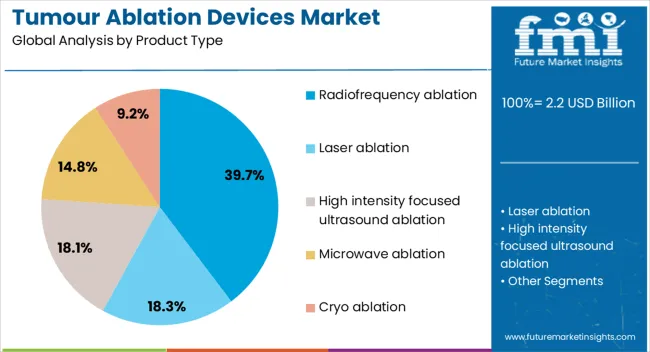
The radiofrequency ablation segment is projected to hold 39.7% of the tumour ablation devices market revenue share in 2025, positioning it as the leading product type. This dominance is being driven by its widespread clinical adoption, cost efficiency, and proven effectiveness in treating various types of tumors. The segment benefits from strong physician preference due to its ability to deliver targeted energy to destroy cancerous tissues with minimal damage to surrounding structures.
Ease of use, relatively shorter procedure times, and compatibility with image-guided systems have further reinforced its market position. The availability of radiofrequency ablation devices across a wide range of healthcare facilities, including tertiary hospitals and specialized oncology centers, has accelerated adoption.
Continuous improvements in device design and precision energy delivery systems are enhancing treatment accuracy and patient safety, contributing to higher procedural success rates With its strong clinical outcomes, affordability compared to other advanced modalities, and proven safety profile, radiofrequency ablation remains the most preferred product type in the global tumour ablation devices market.
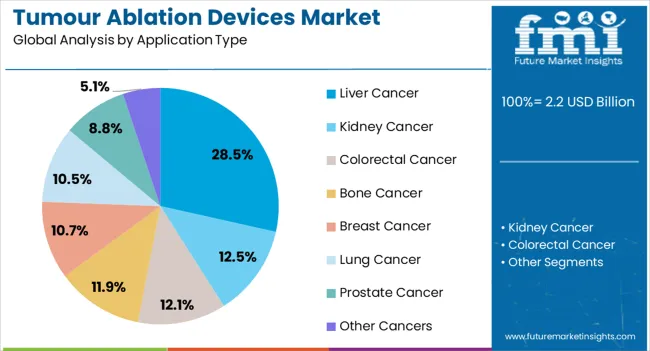
The liver cancer application segment is anticipated to account for 28.5% of the tumour ablation devices market revenue share in 2025, making it the dominant application area. Growth in this segment is being driven by the high prevalence of liver cancer globally, particularly hepatocellular carcinoma, which is one of the most common and aggressive tumor types. Tumour ablation devices provide an effective alternative for patients who are not eligible for surgical resection or transplantation, thereby expanding treatment options.
The ability of ablation therapies to preserve healthy liver tissue while achieving high local control rates has enhanced their role in treatment protocols. Increasing adoption of image-guided ablation techniques, such as ultrasound and CT, has further improved precision and outcomes in liver cancer procedures.
Supportive clinical guidelines recommending ablation as a first-line therapy in specific patient groups have also contributed to its leadership As incidence rates of liver cancer rise and demand for effective, minimally invasive therapies grows, this segment is expected to remain central to market growth.
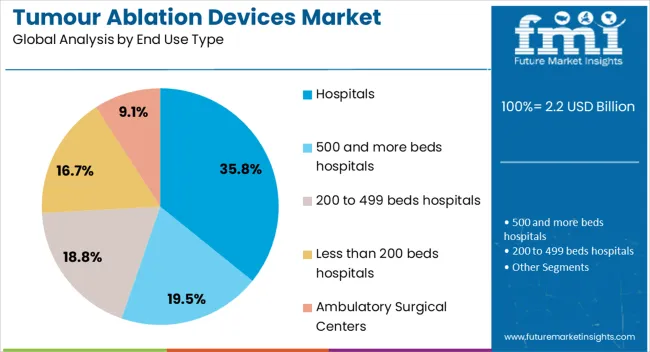
The hospitals segment is expected to represent 35.8% of the tumour ablation devices market revenue share in 2025, establishing it as the leading end-use industry. This dominance is being supported by the concentration of advanced oncology departments and specialized interventional radiology units within hospital settings. Hospitals are the primary centers for cancer treatment, providing access to advanced imaging infrastructure, skilled professionals, and multidisciplinary care teams, which are essential for complex ablation procedures.
The availability of comprehensive reimbursement pathways in many developed regions is also encouraging the adoption of ablation therapies within hospitals. Additionally, the growing demand for minimally invasive oncology procedures has led hospitals to invest in state-of-the-art ablation systems to expand their treatment portfolios.
The segment is further supported by the ability of hospitals to manage both inpatient and outpatient procedures, offering flexibility to patients and physicians As cancer care continues to shift toward integrated and technology-driven approaches, hospitals are expected to remain the largest consumers of tumour ablation devices, reinforcing their dominant market position.
Tumours are the groups of abnormal cells that accumulate together and form lumps and grow consistently. Tumour are categorized into noncancerous and cancerous tumours. Precancerous conditions have the potential of developing into cancer. Tumour ablation is a tool utilized to treat cancerous malignancy. Tumour ablation is the process of removing the cancerous cells from the body.
Tumour ablation became more useful during 1970s and 1980s due to advances in laparoscopic surgical approach. The most common means for definitive treatment of primary and metastatic focal malignancy, is the evolution of imaging devices during the past two decades and image-guided tumour ablation.
Tumours are the groups of abnormal cells that accumulate together and form lumps and grow consistently. Tumour are categorized into noncancerous and cancerous tumours. Precancerous conditions have the potential of developing into cancer. Tumour ablation is a tool utilized to treat cancerous malignancy. Tumour ablation is the process of removing the cancerous cells from the body.
Tumour ablation became more useful during 1970s and 1980s due to advances in laparoscopic surgical approach. The most common means for definitive treatment of primary and metastatic focal malignancy, is the evolution of imaging devices during the past two decades and image-guided tumour ablation.
The lung cancer application segment is expected to grow at the highest CAGR in the next five years due to large patient population of lung cancer present across developing and developed regions. This has increased the investment of manufacturers to develop and commercialize innovative lung cancer ablation products.
The radiofrequency ablation is widely used technique due to specificity of treating target tissue without causing damage to the surrounding cells. Microwave ablation product segment is expected to grow significantly due to increase in adoption rate of microwave ablation devices by healthcare professionals.
Region wise, the global tumour ablation market is classified into regions namely, North America, Latin America, Western Europe, Eastern Europe, Asia-Pacific, Japan, Middle East and Africa.The global market is expected to be dominated by North America due to factors such as early introduction and adoption of rate of tumour ablation products in the region, trend of replacing older technologies and introducing the new technologies, and increase in private and public funding to develop and commercialize the novel tumour ablation products.
The Asia-Pacific market is expected to grow at a higher CAGR in the forecast period due to factors such as large population with the high prevalence of various cancers in the region, government initiatives for developing and modernizing the healthcare infrastructure.
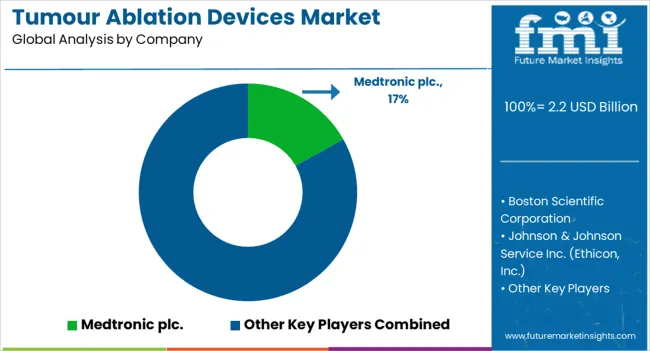
Key players of tumour ablation devices market are Boston Scientific Corporation, St. Jude Medical, Inc., Biotronic NeuroNetwork, LLC, Baylis Medical, biolitec AG, Spectranetics, Esaote SpA, ALPINION MEDICAL SYSTEMS Co., Ltd., Chongqing Haifu Medical Technology Co., Ltd., Koninklijke Philips N.V, Hironic Co., Ltd., Monteris Medical, Inc, EDAP TMS, EYE TECH CARE, NeuWave Medical, Inc, Vison medical, AtriCure, Inc, Galil Medical Inc, ENDOCARE INC, IceCure Medical, Sanarus HealthTronics, Inc, MEDTRONIC, MedWaves, AngioDynamics, Microsulis Medical, Perseon, SympleSurgical Inc. to name a few.
The report is a compilation of first-hand information, qualitative and quantitative assessment by industry analysts, inputs from industry experts and industry participants across the value chain. The report provides in-depth analysis of parent market trends, macro-economic indicators and governing factors along with market attractiveness as per segments. The report also maps the qualitative impact of various market factors on market segments and geographies.
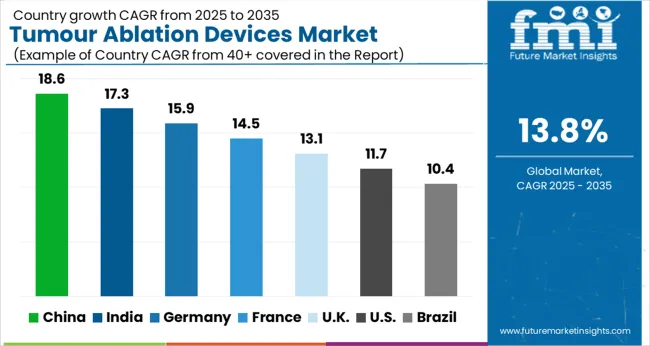
| Country | CAGR |
|---|---|
| China | 18.6% |
| India | 17.3% |
| Germany | 15.9% |
| France | 14.5% |
| UK | 13.1% |
| USA | 11.7% |
| Brazil | 10.4% |
The Tumour Ablation Devices Market is expected to register a CAGR of 13.8% during the forecast period, exhibiting varied country level momentum. China leads with the highest CAGR of 18.6%, followed by India at 17.3%. Developed markets such as Germany, France, and the UK continue to expand steadily, while the USA is likely to grow at consistent rates. Brazil posts the lowest CAGR at 10.4%, yet still underscores a broadly positive trajectory for the global Tumour Ablation Devices Market. In 2024, Germany held a dominant revenue in the Western Europe market and is expected to grow with a CAGR of 15.9%. The USA Tumour Ablation Devices Market is estimated to be valued at USD 777.7 million in 2025 and is anticipated to reach a valuation of USD 2.4 billion by 2035. Sales are projected to rise at a CAGR of 11.7% over the forecast period between 2025 and 2035. While Japan and South Korea markets are estimated to be valued at USD 98.1 million and USD 55.5 million respectively in 2025.
| Item | Value |
|---|---|
| Quantitative Units | USD 2.2 Billion |
| Product Type | Radiofrequency ablation, Laser ablation, High intensity focused ultrasound ablation, Microwave ablation, and Cryo ablation |
| Application Type | Liver Cancer, Kidney Cancer, Colorectal Cancer, Bone Cancer, Breast Cancer, Lung Cancer, Prostate Cancer, and Other Cancers |
| End Use Type | Hospitals, 500 and more beds hospitals, 200 to 499 beds hospitals, Less than 200 beds hospitals, and Ambulatory Surgical Centers |
| Regions Covered | North America, Europe, Asia-Pacific, Latin America, Middle East & Africa |
| Country Covered | United States, Canada, Germany, France, United Kingdom, China, Japan, India, Brazil, South Africa |
| Key Companies Profiled | Medtronic plc., Boston Scientific Corporation, Johnson & Johnson Service Inc. (Ethicon, Inc.), AngioDynamics, Bioventus Inc. (Misonix Inc.), EDAP TMS, Chongqing Haifu Medical Technology Co., Ltd, Mermaid Medical, HealthTronics, Inc., and H.S. Hospital Service S.P.A |
The global tumour ablation devices market is estimated to be valued at USD 2.2 billion in 2025.
The market size for the tumour ablation devices market is projected to reach USD 7.8 billion by 2035.
The tumour ablation devices market is expected to grow at a 13.8% CAGR between 2025 and 2035.
The key product types in tumour ablation devices market are radiofrequency ablation, laser ablation, high intensity focused ultrasound ablation, microwave ablation and cryo ablation.
In terms of application type, liver cancer segment to command 28.5% share in the tumour ablation devices market in 2025.






Our Research Products

The "Full Research Suite" delivers actionable market intel, deep dives on markets or technologies, so clients act faster, cut risk, and unlock growth.

The Leaderboard benchmarks and ranks top vendors, classifying them as Established Leaders, Leading Challengers, or Disruptors & Challengers.

Locates where complements amplify value and substitutes erode it, forecasting net impact by horizon

We deliver granular, decision-grade intel: market sizing, 5-year forecasts, pricing, adoption, usage, revenue, and operational KPIs—plus competitor tracking, regulation, and value chains—across 60 countries broadly.

Spot the shifts before they hit your P&L. We track inflection points, adoption curves, pricing moves, and ecosystem plays to show where demand is heading, why it is changing, and what to do next across high-growth markets and disruptive tech

Real-time reads of user behavior. We track shifting priorities, perceptions of today’s and next-gen services, and provider experience, then pace how fast tech moves from trial to adoption, blending buyer, consumer, and channel inputs with social signals (#WhySwitch, #UX).

Partner with our analyst team to build a custom report designed around your business priorities. From analysing market trends to assessing competitors or crafting bespoke datasets, we tailor insights to your needs.
Supplier Intelligence
Discovery & Profiling
Capacity & Footprint
Performance & Risk
Compliance & Governance
Commercial Readiness
Who Supplies Whom
Scorecards & Shortlists
Playbooks & Docs
Category Intelligence
Definition & Scope
Demand & Use Cases
Cost Drivers
Market Structure
Supply Chain Map
Trade & Policy
Operating Norms
Deliverables
Buyer Intelligence
Account Basics
Spend & Scope
Procurement Model
Vendor Requirements
Terms & Policies
Entry Strategy
Pain Points & Triggers
Outputs
Pricing Analysis
Benchmarks
Trends
Should-Cost
Indexation
Landed Cost
Commercial Terms
Deliverables
Brand Analysis
Positioning & Value Prop
Share & Presence
Customer Evidence
Go-to-Market
Digital & Reputation
Compliance & Trust
KPIs & Gaps
Outputs
Full Research Suite comprises of:
Market outlook & trends analysis
Interviews & case studies
Strategic recommendations
Vendor profiles & capabilities analysis
5-year forecasts
8 regions and 60+ country-level data splits
Market segment data splits
12 months of continuous data updates
DELIVERED AS:
PDF EXCEL ONLINE
Global Ablation Devices Market Trends - Growth, Innovations & Forecast 2025 to 2035
Market Share Breakdown of Thyroid Ablation Devices Manufacturers
Microwave Ablation Devices Market Size and Share Forecast Outlook 2025 to 2035
Ablation Technology Market Size, Share, and Forecast Outlook 2025 to 2035
FBAR Devices Market
Laser Ablation Systems Market Size and Share Forecast Outlook 2025 to 2035
Snare devices Market
C-Arms Devices Market Size and Share Forecast Outlook 2025 to 2035
Timing Devices Market Analysis - Size, Growth, & Forecast Outlook 2025 to 2035
Spinal Devices Market Size and Share Forecast Outlook 2025 to 2035
Hearing Devices 3D Printing Market Size and Share Forecast Outlook 2025 to 2035
Medical Devices Market Size and Share Forecast Outlook 2025 to 2035
Network Devices Market Size and Share Forecast Outlook 2025 to 2035
Medical Devices Secondary Packaging Market Analysis by Material and Application Through 2035
Hearable Devices Market Size and Share Forecast Outlook 2025 to 2035
Lab Chip Devices Market Size and Share Forecast Outlook 2025 to 2035
Orthotic Devices, Casts and Splints Market Size and Share Forecast Outlook 2025 to 2035
Lacrimal Devices Market Size, Trends, and Forecast 2025 to 2035
Magnetic Ablation Catheter Market Outlook – Share, Growth & Forecast 2025-2035
Orthotic Devices, Splints & Orthopedic Braces Market Analysis - Trends & Forecast 2024 to 2034

Thank you!
You will receive an email from our Business Development Manager. Please be sure to check your SPAM/JUNK folder too.
Chat With
MaRIA